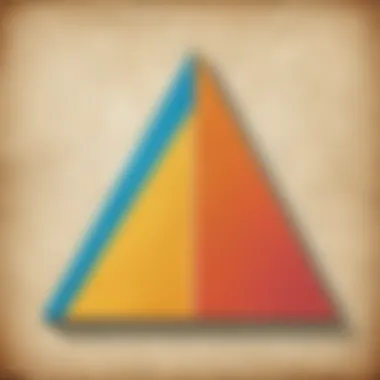Understanding the Adjacent Side of a Triangle


Intro
Understanding triangles is essential in geometry. Among the various sides of a triangle, the adjacent side is particularly important, especially in right triangles. This guide aims to clarify how to identify and calculate the adjacent side while leveraging concepts such as the Pythagorean theorem and trigonometric ratios. A solid grasp of these principles is crucial for elementary school students, as it lays a foundation for more advanced mathematical understanding.
Creative Activities
Engaging students in hands-on activities can make the learning of adjacent sides more relatable and fun. Here are some ideas that are easy to implement:
- Triangle Building with Straws: Using straws cut to different lengths, students can create triangles. Encourage them to label the sides, notably the adjacent side, relative to a chosen angle.
- Geometry Art Projects: Have students create geometric shapes using colored paper. They can specifically illustrate right triangles and color the adjacent side distinctly.
- Measurement Practice: Allow students to measure the length of adjacent sides in real-world objects, such as books or tables. This helps in applying theoretical knowledge practically.
Step-by-Step Guides
- Triangle Building with Straws:
- Geometry Art Projects:
- Measurement Practice:
- Gather materials: straws, scissors, and a protractor.
- Cut straws into lengths that can form a triangle.
- Assemble the straws to form a triangle and label each side.
- Identify the adjacent side concerning one of the angles.
- Provide colored paper and scissors.
- Guide students to cut out triangle shapes.
- Instruct them to color the adjacent side differently to highlight it.
- Give students rulers and a list of objects to measure.
- Encourage them to identify and record the adjacent sides in their measurements.
Educational Value
The activities above help solidify understanding of the adjacent side, providing real-world context to the theory. Crafting triangles strengthens fine motor skills, while measurement activities enhance critical thinking and spatial awareness. Each exercise allows for active participation and encourages exploration of geometric concepts beyond the classroom.
Fun Quizzes
Quizzes serve as an enjoyable way to reinforce the concepts learned about triangles. The following topics are essential:
- Identifying Triangle Parts
- Pythagorean Theorem Applications
- Trigonometric Ratios
Question Types
Questions in quizzes can be varied to keep students engaged. Some examples include:
- Multiple Choice: Students select the correct answer about the adjacent side.
- True/False: Statements regarding properties of triangles.
- Problem Solving: Calculate lengths using given measures of other triangle sides.
Knowledge Reinforcement
Quizzes help reinforce learning by allowing students to evaluate their understanding of the material. By answering structured questions, they apply their knowledge actively, thus cementing the concepts of adjacent sides and their applications in real problem-solving scenarios.
Fact-Based Articles
Reading articles adds depth to students' understanding of related topics. Numerous articles cover various aspects of geometry:
- Triangle Properties and Types
- Practical Applications of Triangles in Architecture
- Historical Context of Triangular Mathematics
Engaging Content
Well-structured articles present information in an engaging manner. They relate concepts to real-life situations, making them easier to grasp for elementary students. The narrative often invites readers to apply their knowledge in practical scenarios.
Prologue to Triangle Geometry
Understanding triangle geometry is fundamental in both mathematics and various practical applications. Shapes formed by three sides are more than just simple figures; they establish the basis for more complex forms. This section emphasizes the key aspects of triangle geometry, offering insight into its significance in learning and real-world scenarios.
Triangles serve as foundational elements in geometry. Recognizing types, properties, and angles allows students to apply these concepts in practical situations. Knowledge of triangle geometry aids in calculations that support disciplines such as engineering, architecture, and physics.
Key elements discussed include types of triangles and their distinct characteristics. Benefits arise from understanding triangles, leading to stronger problem-solving skills. Essential considerations involve how these shapes function in relationships with other geometric figures. Mastery here lays groundwork for exploring more advanced topics such as trigonometry and algebra.
"A solid grasp of triangle properties opens doors to deeper mathematical understanding and creativity."
Defining the Terms
Defining the terms surrounding triangles is essential for grasping the intricacies of geometry. When we talk about triangles, we refer to specific properties and elements that characterize them. Understanding these basic elements lays a solid foundation for further study in geometry. It helps students make sense of more complex relationships within polygonal shapes. Moreover, knowing the definitions allows students to communicate their findings and reasoning clearly. This section will cover two crucial aspects: the relationship between sides and angles and how to accurately identify the adjacent side in right triangles.
Understanding Sides and Angles
In every triangle, there are three sides and three angles. The sides can be referred to by different names based on their positions relative to the angles. For instance, when discussing a specific angle in a right triangle, one might reference the opposite side, the adjacent side, and the hypotenuse.
- Adjacent Side: This is the side that forms one of the angles being considered. It lies next to the angle, directly supporting its measurement.
- Opposite Side: This is the side that does not touch the angle in question. It lies across from the angle.
- Hypotenuse: In a right triangle, this is the longest side, opposite the right angle.
To visualize these terms, consider a right triangle where one angle measures 30 degrees. The side adjacent to this angle helps form it while the opposite side is across from it. Understanding these references allows for better comprehension of triangle properties and is especially important for applying trigonometric ratios.
Identifying the Adjacent Side
Identifying the adjacent side is crucial when learning about right triangles and trigonometric functions. The adjacent side can only be defined when you specify which angle you are considering. For example, in a triangle with angles A, B, and C, if you are focusing on angle A, the adjacent side would be the side that connects angle A to angle B.


- Key Considerations for Identification:
- Always determine the angle to accurately find the adjacent side.
- Remember that the adjacent side will not be the hypotenuse or the opposite side, but rather the one next to the angle of interest.
One good practice is to label the triangle's sides and angles clearly when solving problems. This helps prevent confusion when calculating, especially when using trigonometric ratios. To summarize: understanding sides and angles, as well as accurately identifying the adjacent side, forms the backbone of triangle geometry, setting the stage for deeper exploration of mathematical concepts.
Right Triangles and Their Significance
Right triangles hold a prominent place in geometry due to their unique properties and functionalities. Understanding the adjacent side within right triangles not only enhances comprehension of basic geometry but also establishes foundational skills useful in various advanced mathematical concepts. This article section will illustrate why recognition of right triangles is essential as we explore their characteristics and their importance in geometry.
Characteristics of Right Triangles
A right triangle is defined as a triangle that contains one angle measuring exactly 90 degrees. The key characteristics that distinguish right triangles include:
- Hypotenuse: This is the side opposite the right angle and is the longest side of the triangle.
- Legs of the Triangle: The two sides that form the right angle are termed legs. One of these sides is classified as the adjacent side when referenced from a specific angle.
- Trigonometric Relationships: Right triangles enable the application of sine, cosine, and tangent functions. These functions establish relationships between the angles and the sides of the triangle, particularly focusing on the adjacent side.
Understanding these characteristics enables better calculation and comprehension when dealing with geometric problems involving right triangles.
Importance in Geometry
Right triangles are fundamentally influential across various geometry-related applications. The significance lies in several factors:
- Foundation for Trigonometry: Right triangles serve as the basis for trigonometric principles. This directly connects to finding the length of the adjacent side and applying relevant ratios.
- Real-World Applications: Many structures and designs are based on right triangles. Understanding their properties allows for effective navigation in fields such as architecture and engineering.
- Problem Solving: Working with right triangles aids in developing problem-solving skills. Students can apply logical reasoning when calculating unknown sides or angles.
"The understanding of right triangles shifts mathematical concepts from abstract to practical realities."
In summary, right triangles are not just shapes; they are systems with many functions in math and everyday application. By grasping the significance of the adjacent side within right triangles, students and problem solvers can harness a powerful tool that extends beyond simple classroom exercises.
Using Trigonometric Ratios
Understanding trigonometric ratios is crucial in the context of triangles, especially when it comes to finding the adjacent side. Trigonometry is not merely a collection of formulas; it forms the backbone of many principles in geometry. Through sine, cosine, and tangent functions, students can relate the angles of a triangle to its sides. Grasping these relationships allows for solving real problems, such as calculating heights or distances that might not be immediately measurable in physical settings.
Sine, Cosine, and Tangent Functions
Sine, cosine, and tangent are the three primary functions in trigonometry. Each of these functions connects an angle of a right triangle to the ratios of its sides.
- Sine of an angle in a right triangle is defined as the ratio of the length of the opposite side to the length of the hypotenuse.
- Cosine relates to the adjacent side, showing the ratio of the length of the adjacent side to the hypotenuse.
- Tangent emerges from the relationship between the opposite side and the adjacent side, represented as the ratio of the opposite side to the adjacent side.
These functions help students visualize how angles correspond to side lengths. An understanding of these ratios aids in various calculation scenarios. For instance, knowing how to use the cosine function can directly help with finding the length of the adjacent side when the angle and hypotenuse are known.
Applying Trigonometry to Find the Adjacent Side
To find the adjacent side using trigonometric ratios, one must understand the relationship among the angles and sides in right triangles. The formula generally used involves the cosine function since it directly pertains to the adjacent side.
If we take a right triangle with one angle known, the formula can be structured as follows:
To isolate the length of the adjacent side, rearranging gives:
[ \textAdjacent Side = \textHypotenuse \times \textcos(\theta) ]
This formula is essential for problem-solving in various fields, where accurate measurements and calculations are necessary.
For instance, if the hypotenuse measures 10 units, and the angle is 30 degrees, applying the cosine function yields the adjacent side length as 10 x cos(30), which equals approximately 8.66 units.
In summary, the use of trigonometric ratios serves as a bridge between geometry and practical applications. Understanding these functions and how to apply them enables effective problem-solving in diverse scenarios.
The Pythagorean Theorem
The Pythagorean Theorem is a fundamental principle in geometry, especially when discussing triangles. This theorem applies specifically to right triangles, which have one angle measuring 90 degrees. Understanding this theorem is crucial for determining the lengths of triangle sides, particularly the adjacent side. The theorem states that in a right triangle, the square of the length of the hypotenuse (the side opposite the right angle) is equal to the sum of the squares of the lengths of the other two sides. This relationship is both logical and easy to apply, making it a vital tool in geometric problem-solving.
A key benefit of the Pythagorean Theorem is its ability to relate the sides of a triangle to each other. For students, this provides a structured method to find missing side lengths. Moreover, it serves as a building block for more complex mathematical concepts, particularly in trigonometry.
The Formula Explained
The formula for the Pythagorean Theorem is expressed as:
a² + b² = c²
where:
- a and b represent the lengths of the two legs of the triangle,
- c represents the length of the hypotenuse.
This equation shows that the sum of the squares of sides a and b equals the square of side c. To apply this formula:
- Identify the lengths of the two shorter sides
- Square each length (multiply the number by itself)
- Add the results together
- Take the square root of that sum to find c (the hypotenuse) if it is unknown
When using the formula, the accuracy of measurements is essential. Even a minor error can lead to incorrect results.
Finding Side Lengths with the Theorem
To find side lengths using the Pythagorean Theorem, consider the following example. Suppose you have a right triangle where one leg measures 3 units and the other leg measures 4 units. You want to find the hypotenuse:


- Use the formula:
3² + 4² = c²
9 + 16 = c²
25 = c² - Find the length of the hypotenuse by taking the square root:
c = √25 = 5 unit
In this case, the hypotenuse measures 5 units. The theorem allows students to confidently determine side lengths in real-life situations, from construction to navigation.
Step-by-Step Guide to Finding the Adjacent Side
Finding the adjacent side of a triangle is essential for understanding various geometric principles. This guide provides a structured approach for students and learners of all ages. One benefit of following a systematic method is the ability to build confidence in solving geometry problems. Understanding the position of the adjacent side relative to an angle is crucial in applying trigonometric functions and the Pythagorean theorem effectively. Key elements include recognizing properties of the triangle and how various calculations lead to the correct determination of side lengths.
Basic Example of a Right Triangle
Let’s consider a common right triangle scenario. Suppose we have a right triangle where one angle measures 30 degrees. The side opposite this angle is 5 units long. To find the adjacent side, we can visualize the triangle. In this case, the adjacent side is the one that connects the right angle to the angle measuring 30 degrees.
Using a simple diagram can significantly enhance understanding for elementary students. Drawing helps see the relationships between angles and sides. By labeling the sides clearly, students can consistently denote the adjacent side and its relative position. It is easier to comprehend when the sides are explicitly identified.
Using Trigonometric Ratios for Calculation
Trigonometric ratios, specifically the cosine function, are vital to calculating the adjacent side in right triangles. For our example, the cosine of 30 degrees relates to the adjacent and hypotenuse sides. The formula is as follows:
For our triangle, we can substitute the values into the formula:
- Given (\theta = 30) degrees.
- The length of the hypotenuse can be determined, or if known, is necessary for proceeding.
Assuming the hypotenuse is 10 units, we have:
Calculating (\cos(30)) yields approximately 0.866. Thus, we rearrange the formula to find the adjacent side: [ \textadjacent = 10 \times 0.866 \approx 8.66 \text units ]
This process illustrates how trigonometric ratios are applied to find unknown side lengths effectively. Students should practice multiple examples to become comfortable with these calculations.
Understanding the relationship between angles and side lengths is crucial to mastering triangle geometry.
In summary, this guide not only walks through how to find the adjacent side in various scenarios but also highlights the importance of visualization and calculation techniques. By practicing with real-world applications and simple examples, students will gain a stronger grasp of the concepts involved.
Real-World Applications of Triangle Knowledge
Understanding triangles goes beyond mere classroom exercises. Triangles are fundamental in many practical applications. Learning about the adjacent side of a triangle is not just academic; it has significant real-world implications.
Triangles serve as structural elements. In construction and architecture, they provide strength and stability. This is because a triangle is the simplest shape that can distribute weight evenly. By knowing how to find the adjacent side, architects and engineers can design safer buildings. Correct measurements in triangular configurations ensure that the structures can support loads without fatigue or failure. By using the properties of triangles, professionals can offer designs that optimize materials while ensuring robustness.
Construction and Architecture
The use of triangles in construction dates back centuries. Modern engineers apply trigonometry to calculate parameters involved in building designs. The adjacent side plays a critical role in determining not only the dimensions of a triangle but also how each component will work together.
For example, if an architect wants to create a roof design, understanding how to find the adjacent side of the triangle can indicate the roof's slope. A steeper slope might require different materials compared to a gentler incline. Therefore, knowing this side's length can help predict costs and material needs.
In such cases, having a firm grasp on how to calculate the adjacent side using the appropriate formulas can lead to efficient and effective buildings. By utilizing tools such as a protractor or a level, builders can ensure their angles are correct, thus reinforcing the dimensional integrity of their structures.
Navigation and Mapping
Triangles also have a place in navigation and mapping. Geographic features can often be represented using triangles, helping to simplify complex terrains. When navigating, knowing distances between points can assist in plotting the most effective and shortest routes.
Calculating the adjacent side from given angles allows for more accurate map readings. This aspect is vital in fields like aviation and maritime navigation. Finding the adjacent side aids in understanding distances and angles involved in travel routes. Geometry comes into play when transport engineers design road layouts. They ensure that roads meet at proper angles for safety and functionality.
In summary, recognizing and calculating the adjacent side of a triangle can significantly affect various fields from architecture to navigation. Understanding these concepts forms a solid foundation for further applications in everyday life.
Common Mistakes in Triangle Calculations
Understanding the common mistakes in triangle calculations is crucial for mastering the geometry concepts surrounding triangles. When learning about triangles, students, parents, and caregivers may often misinterpret the relationships between the sides and angles. This misunderstanding can lead to errors in calculations and a lack of confidence in problem-solving abilities. By identifying and addressing these mistakes, learners can improve their comprehension of triangle properties and enhance their skills in geometry.
Misunderstanding Side Relationships
One of the primary mistakes learners face is misunderstanding side relationships within triangles, especially concerning the adjacent side. Often, students might confuse the adjacent side with the opposite side or the hypotenuse. The adjacent side is the side right next to a given angle, not opposite to it. This confusion can arise particularly in right triangles where the relationships between the angles and sides are clearly defined.
To clarify this, it is essential to emphasize that in a right triangle, each angle defines its own adjacent and opposite side. For instance, if we consider an angle of 30 degrees in a right triangle, the side that forms the angle with the hypotenuse is the adjacent side. Conversely, the opposite side is the one that does not touch the angle. This distinction is necessary for applying trigonometric ratios correctly to find side lengths, which is a critical skill in math.
Here's a recap of key points to remember about side relationships:
- Adjacent Side: The side next to the angle in question.
- Opposite Side: The side across from the angle in question.
- Hypotenuse: The longest side of a right triangle, opposite the right angle.
To reinforce this understanding, visualization aids such as diagrams or drawings of right triangles can be very beneficial.
Errors in Using Formulas
Another common mistake involves errors in using the formulas related to triangles, particularly the trigonometric identities. Students might incorrectly apply the sine, cosine, or tangent functions, leading to inaccurate results when determining the lengths of sides. Each function relates the angles of a triangle to the ratios of its sides. Therefore, it is vital to know which formula corresponds to which side and angle combination.
For example, remembering that:
- Sine relates the opposite side to the hypotenuse.
- Cosine connects the adjacent side to the hypotenuse.
- Tangent links the opposite side to the adjacent side.


Failing to recall these relationships can result in wrong calculations. In addition, misplacing a decimal point or improperly calculating the square root can cause significant errors in results.
To avoid errors, practice using these formulas with varied examples. Gain confidence and accuracy through repeated use and review.
To help mitigate these mistakes, it is helpful to create checklists or worksheets that outline the correct use of formulas. Students can cross-reference their work when calculating the adjacent side, ensuring they follow the correct process.
By understanding common mistakes it is possible to build a solid foundation in triangle calculations. Misunderstanding side relationships and errors in formula application can lead to confusion and frustration. With practice and additional resources, learners can overcome these hurdles and achieve a better grasp of triangle properties.
Visual Representation of Triangles
Visual representation of triangles is crucial in grasping geometry concepts. This section explores how diagrams and drawings aid in understanding the adjacent side of triangles. It helps students visualize relationships between angles and sides, a significant aspect of triangle geometry.
Using accurate drawings is not just about aesthetics; it deepens comprehension. When triangles are drawn correctly, students can clearly identify the adjacent side relative to a given angle. This understanding is fundamental when applying formulas, especially in right triangles. Visualization can also prevent mistakes that might arise from purely numerical work.
Diagrams make it easier to apply trigonometric functions and the Pythagorean theorem. Overall, visual tools simplify problem-solving, reinforcing learning in a practical way.
Drawing Triangles Accurately
To get the most out of triangle geometry, accurate drawings are paramount. When students draw a triangle, they should pay attention to the following points:
- Start with a clear base line for alignment.
- Use a ruler to ensure straight sides.
- Measure angles carefully, especially when dealing with right triangles.
When the triangle is drawn precisely, it allows for immediate recognition of the adjacent side. Students should practice drawing various types of triangles, ensuring that the proportions remain true.
Key considerations include:
- Indicating the right angles in right triangles.
- Labeling each side appropriately.
- Using clear notation for angles.
Good examples on drawing can be found on educational sites like en.wikipedia.org and britannica.com.
Using Diagrams in Problem Solving
Diagrams serve as a powerful tool in problem solving. Here’s how students can utilize them effectively:
- Refer to accurate diagrams when identifying sides like the adjacent side.
- Annotate the diagrams with relevant information such as angles and lengths.
- Visualize the relationships between sides and angles through clear representations.
Additionally, students can use digital tools to create diagrams. This can enhance their understanding by allowing students to manipulate figures and see how changes affect the triangle properties.
Using diagrams also helps teachers explain concepts more clearly. By visually demonstrating problems, they engage students and invite deeper learning.
Resources for Further Learning
Learning geometry can be complex, especially when it comes to understanding the roles of different sides in triangles. Resources for Further Learning play a critical role in reinforcing the material taught in class. They provide additional context and perspectives that can deepen understanding. Accessibility to various types of materials can cater to different styles of learning. This section will outline helpful resources such as books, online materials, and interactive tools that are beneficial for grasping these concepts.
Books and Online Materials
Books are traditional yet effective means to gain knowledge. They offer structured content and coherent explanations. Here are some recommended resources:
- Geometry: A Comprehensive Course by Daniel Altshiller-Court. This book covers the foundational elements of geometry, including triangles.
- Geometry For Dummies by Mark Ryan. This guide simplifies tricky concepts, making it easier for students to understand.
Online platforms also offer a wealth of information. Websites like Britannica provide articles and resources tailored for different education levels. These online sources often include videos and animations which can clarify concepts visually.
Interactive Learning Tools
Interactive learning tools are invaluable for young learners. They engage students actively, facilitating a hands-on approach to understanding. Some resources include educational apps and websites:
- Khan Academy: This platform provides video lessons along with practice exercises tailored to various geometry topics.
- GeoGebra: An interactive geometry tool that allows users to visualize and manipulate triangles, helping in understanding the concept of the adjacent side.
These tools can motivate students by making learning dynamic and fun. They can experiment with geometry in an engaging way, which often leads to better retention of knowledge.
"Learning through interaction not only promotes interest but also solidifies understanding in young minds."
Combining these resources will create a robust foundation for elementary school students. Access to books, online materials, and interactive tools will enhance their geometric literacy and foster a strong appreciation for the subject.
Epilogue
Learning about triangles offers students an opportunity to develop critical thinking skills. By grasping concepts surrounding the adjacent side, students can visualize the relationships between angles and sides in practical scenarios. Through trigonometric ratios, particularly sine, cosine, and tangent, the process of determining the lengths of these sides becomes simpler and intuitive.
Key points discussed in this article include:
- Definitions of important terms related to triangles.
- The specific role of the adjacent side in right triangle situations.
- Applications of trigonometric ratios in calculating the adjacent side.
- Relevant real-world examples to illustrate these concepts further.
Thus, reinforcing these concepts is a pathway to deeper mathematical understanding. Encouraging students—along with parents and caregivers—to apply this knowledge will enhance their appreciation of geometry.
Recap of Key Concepts
The article examined several crucial elements. Firstly, we defined what the adjacent side is and its significance in the context of right triangles. Secondly, we explored the trigonometric ratios in depth, helping to clarify their application in finding the length of the adjacent side. By discussing the Pythagorean theorem, we showcased its relevance when tackling triangle calculations. These ideas are not only critical in math but also hold relevance in real-world applications—making abstract concepts tangible.
Encouragement to Explore Further
Encouraging curiosity in students is vital. Learning about the adjacent side opens up further study into advanced topics like trigonometric identities and 3D geometry. Students should continue exploring these areas to build a solid foundation for higher mathematical learning. Parents and caregivers can support this exploration by introducing practical projects, such as measuring areas and angles in their surroundings.
Resources that can enhance this journey include interactive learning tools found online. Websites such as en.wikipedia.org and britannica.com can provide additional insight into geometry and its applications. Further, students can engage with platforms like reddit.com to ask questions, share ideas, and learn collaboratively. Such explorations will make the learning experience more enriching and enjoyable.







